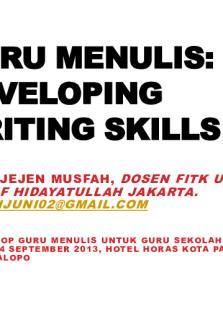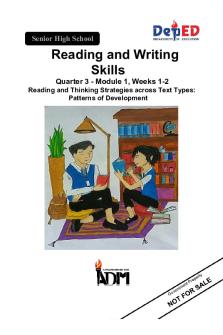Reading Skills PDF

| Title | Reading Skills |
|---|---|
| Author | Anonymous User |
| Course | Communication Skills |
| Institution | Barkatullah University |
| Pages | 4 |
| File Size | 69.5 KB |
| File Type | |
| Total Downloads | 106 |
| Total Views | 168 |
Summary
Reading skills and techniques...
Description
1. 2. 3. 4.
a) b) c) d)
READING SKILLS Definition A simple (and provisional) definition of reading is that it is a process whereby one looks at and understands what has been written. This definition of reading does not mean that one needs to understand everything in a text. Understanding is not an "all or nothing" process and from that it follows that reading is not "all or nothing" process either. Reading involves many sub skills for example-literal comprehension, inferential comprehension, interpretation, evaluation and critical appreciation. The process of reading has the following characteristics. It is both a physical and mental activity. It requires attention and thought. It involves the participation of the reader emotionally and intellectually. It involves interpretation of the written (printed) symbols. Different readers may interpret the same text differently. This implies that readers put meaning into what they read. The meaning that a reader may put on a piece of writing is determined by several factors. For example, the reader's background, knowledge or experience, emotional appeal of the subject or the reader's intellectual ability. Reading is a very versatile activity because it can take place almost anywhere: in a classroom, library, house, vehicle, train etc. Purposes for reading Reading for pleasure/entertainment Acquiring knowledge and information: to be informed about the world you live in. Reading for academic purpose Materials that can be read for academic information are: textbooks, reference books, general and specialist journals, magazines and special sections of newspapers. Reading for instructions or directions: food and clothing labels, instructions on drugs, operational manuals on machines etc.
Types of Reading There are several types/ways/techniques of reading. They are previewing, skimming, scanning, word for word reading, light reading, intensive/study/critical reading and extensive reading. a) Previewing It involves looking over a text to determine its relevance and worth for a specific reading purpose. It helps the reader to predict in a very short time, what a reading text is all about and to determine its degree of relevance. You then can decide whether to read the book or not, or whether to read a part or parts of it and which part. Previewing a text is done by looking at the following: i) Front matter: title, forward/preface or introduction, table of contents. ii) Back matter: blurbs, index, glossary, bibliography. iii) The book itself: Headings, subheadings, organizations, language, content, diagrams.
b)
Skimming Used when a reader wants to get the main idea or gist of a text within a very short time. When skimming, you need to read the topic sentences only. The topic sentence is usually the first in a paragraph and expresses the main idea. But sometimes a writer may choose to make the second sentence of a paragraph the topic sentence. On rare occasions, a writer may make the last sentence of the paragraph the topic sentence. This is determined by the writing style that a writer may adapt to convey certain information. You can skim through a long text or even a book in just a few minutes and get the gist of the text.
c)
Scanning It involves searching for particular items of information. You are interested in these items only and not everything in the text.
d) Word by word reading; This reading technique is used when one is learning how to read for the first time. You might use this technique if you decide to learn a new language. Word for word reading means trying to understand fully one word or phrase at a time. It is a slow reading technique. Scientists and mathematicians use it when they are studying processes and formulae.
ii)
e)
Light reading This is the way most people read most of the time. There is neither an attempt to digest the material that is read nor is there any attempt to assess it critically. This type of reading tends to be fast and superficial. It is the type of reading most people apply when reading newspapers and novels. This kind of reading is not recommended for study purposes but you can use the technique when reading for leisure.
f)
Intensive reading Intensive reading entails content study of what is read in some detail and study of language in which the material is written. Intensive reading calls for a deep and thorough understanding of what is written. The concern is with detailed comprehension of short texts-typically not more than five hundred words in length. Intensive reading implies approaching a text under the guidance of a task (or a teacher) which forces the student to use analytical, critical and evaluative skills. It is the type of reading a university student engages in when studying. To be an efficient intensive reader, you need to get rid of some bad reading habits: i) Trying to understand every word that you read by consulting the dictionary from time to time. Slows down reading and interferes with concentration. Vocalization or moving lips as you read. This slows down reading to a speaking pace and is therefore inefficient.
iii)
Retrogression. This means reading forwards and backwards. It hinders comprehension unless you are doing word by word reading. Pointing - using a finger, pencil or pen over what is being read or nodding the head. This is not only slow but also clumsy
iv) g)
a)
b)
c)
d)
Extensive Reading Extensive reading might be said to emphasize the process whereby a student comes to understand a book without fully grasping every point of it, or even trying to. Strategies such as skimming and scanning are important here, but there are also others such as recognising the contribution of 'plot' or 'argument' to understanding a text. Extensive reading usually involves long texts or books with many pages - or just wide reading. The objectives of extensive reading are: to promote enjoyment of reading, to provide various experiences, and to provide wide exposure to written English in use. TEXT READABILITY This is the extent to which it is possible to read a text and comprehend its content. It refers to the relative simplicity or difficulty in understanding, interpreting, evaluating or applying the information in a text. Factors determining text readability The language level. This includes new words and other technical or scientific terms which one is not familiar with It may also refer to sentence structures, stylistic devices, register, idiomatic expressions used etc. Content This refers to the subject matter. It could be elementary or advanced depending on the level of education of the reader. Layout This is the arrangement or structure of the text in terms of chapters, units, paragraphs and even sentences. The way a text is structured makes it possible to follow the trend of though of the writer. Print size The size of the print, the front size are also important factors. Very small print is uncomfortable and tiring to read.
How to comprehend a difficult text Vocabulary One can understand new words, difficult terms, phrases or expressions without using a dictionary. This can be done by: -looking at the context clues, getting synonyms, using predictions and using inference b) Predictions This is when one reads to confirm expectations. This technique is highly motivating and gives one a purpose for reading. c) Inference/implications (“reading between the lines”) This is 'reading' beyond what you can see in print, on pages. It calls for reasoning, reaching an opinion, making conclusions. It is important when answering questions on a)
meanings of words, phrases as used in the passage and also identification of the connotations of different sentences. d) The SQ3R reading method This is a special skill useful in reading. The abbreviation SQ3R stands for the steps that one reader follows while using this method of reading. These are. i) Survey -Glance over the titles or chapter headings to establish the subject of the text. -Read the whole of the first paragraph; in case of a passage -Read the first sentence in each subsequent paragraph -Read the whole of the last paragraph -In case of a book, read chapter summaries or conclusions. ii) Question -Turn the first heading into a question. This will arouse your curiosity and thereby increase your comprehension. -The question will also make important points stand out, at the same time, explanatory details will be recognised. -In case of passages or even some books, you could also look at the questions in the text. iii) Read -Read the text to establish the subject matter, the writer’s approach and get the general gist. Try to obtain quick answers for the questions you raised in (ii) above. iv) Revise At this stage, you get into active reading and search for information and answers to specific questions. You ought to make notes. You should be guided by the topic sentences and the supporting evidence as well as the discourse markers (idea connectors). They will show you the trend of argument of the author. v) Recite -Having read and revised, now look away from the text and try to recall and recite the answers to the questions raised or thought about. -Use your own words and cite some examples -If you can recite, you know what is in the book; if you can't glance over the section again. -An excellent way to recite from memory is to write down brief notes or phrases in outline form, on a piece of paper. NB: stages 3 and 4 should enable you to make good notes....
Similar Free PDFs

Reading Skills
- 4 Pages

Skills Critique
- 1 Pages

Writing Skills
- 29 Pages

Skills intelligence
- 5 Pages

Clinical Skills
- 8 Pages
Popular Institutions
- Tinajero National High School - Annex
- Politeknik Caltex Riau
- Yokohama City University
- SGT University
- University of Al-Qadisiyah
- Divine Word College of Vigan
- Techniek College Rotterdam
- Universidade de Santiago
- Universiti Teknologi MARA Cawangan Johor Kampus Pasir Gudang
- Poltekkes Kemenkes Yogyakarta
- Baguio City National High School
- Colegio san marcos
- preparatoria uno
- Centro de Bachillerato Tecnológico Industrial y de Servicios No. 107
- Dalian Maritime University
- Quang Trung Secondary School
- Colegio Tecnológico en Informática
- Corporación Regional de Educación Superior
- Grupo CEDVA
- Dar Al Uloom University
- Centro de Estudios Preuniversitarios de la Universidad Nacional de Ingeniería
- 上智大学
- Aakash International School, Nuna Majara
- San Felipe Neri Catholic School
- Kang Chiao International School - New Taipei City
- Misamis Occidental National High School
- Institución Educativa Escuela Normal Juan Ladrilleros
- Kolehiyo ng Pantukan
- Batanes State College
- Instituto Continental
- Sekolah Menengah Kejuruan Kesehatan Kaltara (Tarakan)
- Colegio de La Inmaculada Concepcion - Cebu










